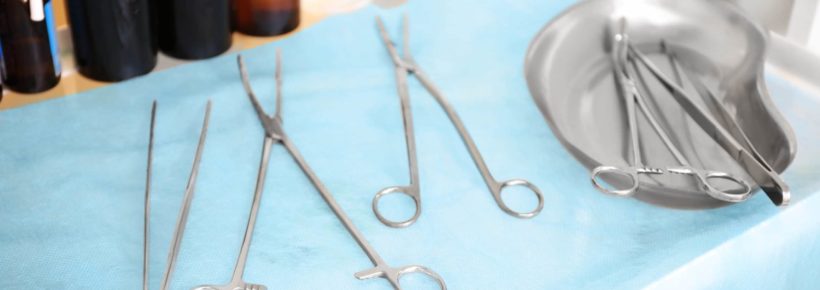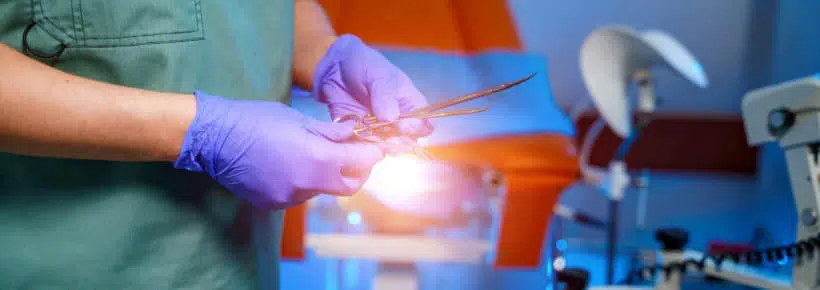Is the Abortion Pill Safe?
The abortion pill, referred to as RU-486 or a medication/chemical abortion, was approved by the FDA in 2000. In recent years, the abortion pill has become a widely-used form of chemical abortion in the United States. Consisting in a two-pill series, mifepristone (Mifeprex) and misoprostol, the procedure works by stopping the production of progesterone, blocking nutrients to the fetus and causing the uterus to shed its lining. The final stage triggers severe cramping and heavy bleeding as the mother delivers the dead child. It’s a stress-free abortion procedure for the abortion doctor, which leaves the patient to deal with any potential side effects on her own.
There are few safeguards surrounding the abortion pill, increasing the potential for serious side effects. The FDA currently requires a woman seeking a chemical abortion to see a doctor to ensure she does not have an ectopic pregnancy (i.e., a fertilized egg attached outside the uterus) or another pregnancy related condition that may result in life-threatening complications. The pregnancy must be accurately dated as the abortion pill is authorized for use only 10 weeks after the mother’s last period, or up to 7 weeks from fertilization. At this stage, a child has a heartbeat and its organs are fully developed.

Medically accurate illustration of a fetus at 10 weeks
Indeed, the health risks associated with one of the drugs (mifepristone) are serious enough to warrant a rare safety requirement called REMS, or Risk Evaluation and Mitigation Strategy. According to the FDA, “REMS is a drug safety program that the [FDA] can require for certain medications with serious safety concerns to help ensure the benefits of the medication outweigh its risks.”
However, these safety protocols are being stripped away in order to ensure access to “underserved” populations. The abortion pill is dangerous in many ways to all women, and the decision to allow women to administer the medication without medical supervision only adds another layer of risk.
Unsurprisingly, failure to comply with safety standards is not unusual. For example, an ectopic pregnancy can only be diagnosed with an ultrasound, a procedure often skipped. In addition, a pregnancy will sometimes be incorrectly dated on purpose in order to prescribe the abortion pill to women farther along in their pregnancies.
If this at-home procedure doesn’t sound uncomplicated, straightforward, and relatively risk-free, that’s because it isn’t. Many women have come forward with deeply upsetting stories of their abortion pill experiences. And yet they have been consistently ignored, invalidated, or deemed unimportant. These stories serve as a warning, but also shed light on the widespread lack of attention and concern displayed by the abortion industry and media towards women who believed in their propaganda, services, and procedures.
4 Abortion Pill Stories
1. Natalia
“Of course, it’s painful. It feels like you’re being stabbed in the stomach. It’s unbearable, the pain. I looked down and I saw him [the baby]. It wasn’t like a heavy period. It was like a baby.”
In a video released by March for Life UK, a young woman recounts the medical negligence she encountered and the physical and emotional effects she endured after taking the abortion pill. Natalia was 20 years old when she became pregnant during the COVID-19 pandemic. Her boyfriend pressured her to have an abortion, and friends who also had had abortions encouraged Natalia to follow through with the procedure after she backed out twice.
My Abortion Story – Natalia’s Story. from March for Life UK on Vimeo
Following a counseling session at the clinic, a doctor estimated Natalia’s gestational age and prescribed her the abortion pill. She says, “I was never told about the risks … emotionally and physically. I wasn’t aware of them. I was never offered a scan. So, it was never like they actually knew how far along I was.”
After taking the abortion pill home, Natalia waited three weeks until being pressured by her friends to abort. The child’s father wasn’t speaking to Natalia and her friends encouraged her to take the pill and fix the relationship. Natalia recounts her profound reluctance: “I remember saying so many times … don’t make me do it; I don’t want to do it.”
The irony of the abortion industry lies partly in its branding as a force of female empowerment. Many abortion stories portray women with insecurity, shame, and doubt succumbing to pressure by society, friends, or loved ones to make a decision they are unsure about.
Several hours after taking the medication, Natalia began experiencing intense pain. A few hours later, she went to the bathroom and saw her child in the toilet.
That night was so hard…. I remember throwing up [the pill] at 1am. The physical pain is nothing.… Of course, it’s painful. It feels like you’re being stabbed in the stomach. It’s unbearable, the pain. I looked down and I saw him [the baby]. It wasn’t like a heavy period. It was like a baby.
The dangerous physical side effects lasted several days: “I’ve thrown up again. I’ve taken all these codeines but they’re just coming up. I laid in my bed, but I was bleeding through the mattress. I laid there about three days on my own, not wanting to speak to anyone.”
The abortion pill isolates women, leaving them vulnerable and lacking basic information in regards to the short and long-term effects of the procedure. Many are too afraid or physically weak to reach out for medical assistance.
2. Anonymous Feminist
“The feminist in me shrinks away from talking about the pain of that loss.… There’s a fountain of pain and a kind of aloneness I had never experienced that seems to gush interminably.”
A young, self-described “feminist, leftist, and liberal-educated” woman recounts the severe physical pain she experienced with the abortion pill and the uterine infection that followed.
During her visit to Planned Parenthood, she was given the first of the two medications – Mifepristone – and sent home with instructions on how to administer the rest of the pills to herself.
I asked if I’d feel sick before taking the second round. It’s unlikely, they said. I woke up vomiting, and I vomited all day until I wished I were dead, especially knowing that I had to take pills that do cause nausea and vomiting. Severe cramping, bleeding, and more vomiting ensued within 30 minutes of taking the misoprostol. That was when I wished I could change my mind and have a surgical procedure instead. The unbearable pain continued for several hours, but eventually I was able to rest. I’ve since read in some forums that it goes on for hours and hours for some women. I can’t even imagine.
Acknowledging the debilitating pain and unknown risks associated with the abortion pill feels like a betrayal for many abortion activists. This woman shares how her belief system conflicted with her desire to talk about her distressing experience: “The feminist in me shrinks away from talking about the pain of that loss. Even though my heart believes I sent it back so it could return at a better time, there’s fountain of pain and a kind of aloneness I had never experienced that seems to gush interminably.”
Following her abortion, the woman sought medical help for symptoms of a serious infection.
A week later, I was experiencing significant pain and a fever, so I went back to PP. There, they diagnosed a uterine infection and gave me more antibiotics.… Now I worry that the infection may have done enough damage to make conception difficult in the future. It’s really terrifying. And there’s nothing I can do about it.
The uterine infection was treated, but its effects on the woman’s fertility is unknown. A decision which was advertised as a solution to a serious problem left this woman physically injured and possibly infertile.
3. Nelle
“They assure you there is literally zero risk and that it is quick, private, and like a period. Which is all a lie! I was completely misinformed and lied to. I feel very manipulated.”
Another young woman, Nelle, shares how she was lied to and misled by clinic staff.
The ENTIRE time I was there I was told LIES! They said, “There are no real risks, this is like a period, light cramping, it’ll all be over within 2 days.” They assured me I didn’t have to do anything. I didn’t want to!
I asked a Million Questions. Planned Parenthood assured me I was going to be fine, and it would all be over in 2 days….
Of course, I had to read the packet they didn’t go over with me, and inside it said I might bleed for up to 3 weeks. 3 WEEKS!
No one actually says that you BLEED FOR WEEKS! NO ONE!
That would have been great to know beforehand. I would have NEVER opted for this method if I knew that vital piece of information.
I had asked multiple nurses and they assured me it would all be clear within a few days!
They chalk it up to be so “Natural” and “Easy” when this was in fact more “Painful” and “Traumatizing” than an in-clinic surgical abortion!
Anyway, it hurt like crazy and I have never been more nauseated and in pain in my life. I was a sweaty, bloody, crying mess. The cramping was pretty bad for me but it was the fact of feeling the chunks fall out of you. I sat on the toilet and eventually put on a maxi pad and sat on the couch. It was about 3-4 hours of cramping until it came out….
I truly believe Planned Parenthood tricks young girls into getting these type of abortions, solely to keep them running.
They don’t make money off of birth control. This is how they make money.
They assure you there is literally zero risk and that it is quick, private, and like a period. Which is all a lie! I was completely misinformed and lied to. I feel very manipulated.
The abortion industry, lawmakers, and the FDA consistently lie to women by minimizing and misrepresenting the risks associated with the abortion pill. Women seeking an abortion are misinformed – at every level – to believe the abortion pill is a harmless and efficient abortion method.
4. Rose
“It felt like an act of self-violence. I remember walking back out into the waiting room and folding into my mom’s arms—crying with a ferocity I hadn’t experienced since childhood.”
In an article for Vice, a woman named Rose Stokes writes about choosing the abortion pill, believing it was safe until it failed and she was forced to undergo invasive surgery. Rose had little knowledge about how the abortion pill worked and a clinic staff member was unable to provide a meaningful explanation.
“’Well, one you take a pill and the other is more invasive.’ … I went for the medical abortion, assuming it would be simpler.”
Vague and brief explanations of abortion procedures are regularly given by abortion providers and activists to women looking for basic information about what happens to their bodies.
Almost immediately after taking the first pill Rose experienced extreme anguish.
The nurse at the preliminary appointment explained that early medical abortions (EMAs) are most effective if you take the two sets of pills 24-48 hours apart. I took the first pill (mifepristone) on that day, and came back two days later to complete the procedure, which involved inserting the second set of pills (misoprostol) into my vagina. It felt like an act of self-violence. I remember walking back out into the waiting room and folding into my mom’s arms—crying with a ferocity I hadn’t experienced since childhood.
There is no such thing as a non-invasive abortion. In the case of the abortion pill, the violence is left to the woman to inflict on herself and her unborn child.

Not an image of Rose
The clinic staff downplayed the range of possible and likely symptoms. Rose was completely unprepared for the amount of the pain she experienced.
[The clinic told me] It would be much like a heavy period, and should be over within a day, but that I could have some mild cramping for up to a week.… Around four hours later once we’d returned to the apartment, I felt an unfamiliar pain stir deep inside me, somewhere in between my lower spine and belly button. Within an hour, I had gone into full labor—I’ll spare you a long description, but: contractions, vomiting, bleeding, crying, s***ing.
However, Rose felt assured the abortion was complete until she began to feel sick a week later.
[My doctor] took my blood pressure—which he said was “dangerously low”—and sent me straight to the hospital.… After four hours of crying in agony, lying on the floor of the waiting room in the Pregnancy Unit among expectant mothers, a scan revealed what I was afraid of: that the abortion had not been successful…. Surgery was scheduled for three days later to remove the “remaining products” …. The whole ordeal left me physically and emotionally wrung out.
The Takeaways
The abortion pill is an unsafe, high-risk, and careless method of encouraging more abortions. Women are routinely kept in the dark about its dangers. The campaign to depict chemical abortion as stress-free and relatively pain-free has injured thousands of women, whose testimonies show the abortion pill is fundamentally unsafe. Abortion doctors fail to warn women of unbearable pain, continuous blood loss, and forceful vomiting. Widespread misinformation is spread by abortion clinics, the mainstream media, and on social media platforms. As a result, the abortion industry continues to victimize women.
Because the bottom line of the abortion industry is not the health and safety of women.








Abortion is a choice nobody wants to make. Those who call their unborn baby it or seem ok with it are just wearing an armour to help them deal with the situation.
Surgical abortion, while again not a pleasurable experience, done by the right professionals is a safe and highly successful choice. The action of taking the child’s life is taken out of the hands of the mother and put into the hands of professionals.
The medical abortion is a product from the devil himself. They sell it to you like you’ll be able to walk the dog that afternoon. The pain associated along with the mental trauma is extremely disturbing.
I like most women did a medical abortion at home alone. I honestly thought I was going to die.
The medical abortion is the only legal form of murder a regular person can just go and buy these pulls and then take the life of a living child inside them. I’m sorry, I don’t get paid enough for that
The physical pain a woman experiences from any type of abortion is just horrible and
no one should experience such suffering!
The mother’s body is responding to the physical pain and suffering her baby is
experiencing in real-time. Her baby feels agonizing pain when life-sustaining nutrients
and oxygen are very slowly being depleted until his or her last breath and dies.
Killing your own baby goes against the innate nature of protecting your child at all costs.
There are many resources of support available to women to keep their babies.
There are businesses even at your local hospital that has Prenatal Clinics offering free ultrasound,
free medical for mother and baby, free baby supplies, child care training, free housing,
the list goes on and the abortion clinics will not share this with the mother because they
want you to feel helpless and alone. Love God, Love Life, Protect Life, and Love Neighbor
is my daily prayer. Mothers are precious and so are their babies. Chose Life! The support is there
for both of you. You are not alone. I am praying for you. Trish
Out of genuine curiosity, whiy do people who are pro life also vote for the death penalty? Doesn’t that contradict itself?
Are you DENSE? The death penalty is for people who CHOOSE, and KNOWINGLY do bad things! An unborn child is a DEFENSELESS, INNOCENT human! The fact that you’d compare the two is DISGUSTING!
Not all of us. Many of us will define life from the womb to the tomb.
There are 2 schools of thought regarding how we can most accurately refer to those talking part in abortions.
One mindset approves referring to these persons as “doctors” while the other calls them abortionists.
I firmly advocate speaking the truth to and about those persons who deliberately kill defenseless prebirth human beings, which is that they should never receive the same respect as a doctor nor midwife or other professional in the field of obstetrics who not only condones but commits and encourages abortions, rather than one who staunchly reveres life and supports legal
protection for human lives at all stages of life.
“IT came out”😔
That was my thought, exactly! Referring to the child she just slaughtered as “it” was repulsive. No human dignity whatsoever. 😞
What else can we expect from those who deep down do not care about human life? We live in an age when common sense is in short supply; when animals enjoy better rights than Man, created in the Image and Likeness of God! Pray and do penance; resist by whatever legitimate means are at our disposal! Oremus!
These testimonies to the dangerous and damaging effects of the postal abortion pills are horrifying. What hypocrisy is being manifested by the abortion industry towards women in these days.
May all the deception be exposed and brought into the light.